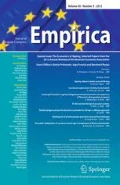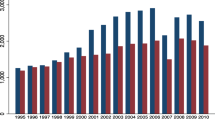Abstract
In this paper we analyse the role financial constraints play in firm expansion in both domestic and export markets. We use data on Slovenian manufacturing firms that were active between 2001 and 2012. In contrast to existing studies, we use generalized propensity score and continuous matching techniques to estimate the effects of differences in access to bank financing. We show that the response of sales to measure of access to external funds differs considerably between firms of different size. The largest effect of additional external funds is observed for small firms. Moreover, the relationship between debt and domestic/foreign sales is non-monotonic, displaying a pronounced inverse U-shape. Thus, an increase in debt financing may cause a decrease in exporting and domestic sales for some levels of indebtedness, while stimulating it for other levels.






Similar content being viewed by others
Notes
Using a sample of Slovenian manufacturing firms, Damijan et al. (2010) confirm that liquidity constraints significantly hamper expansion of new exporters in foreign markets both in terms of the number of products exported and the number of destinations served.
There is ample evidence suggesting that the sunk and variable costs of exporting have been decreasing substantially over the past few decades with the rapid evolution of information and communication technologies. While the effect of these technological improvements is very sector specific, these changes have enabled firms to tap into markets that would have been unreachable only a decade ago.
The latter is made more difficult by the “funding gap” (see Hall and Lerner 2010 for innovation financing) that could be present in financing export ventures as opposed to domestic expansion. Effectively, due to the “lemons problem”, investment in exports may be underfinanced.
This suggests that small firms are likely to finance their operations with trade credit.
We also used alternative measure of firm size—number of employees as a robustness test. The key results were, however, qualitatively similar and are thus omitted from the text.
In order to work with the largest possible sample size we consider contemporaneous impact of financing constraints on export intensity. However, we also test the robustness of this approach by lagging both sides of by one period. The results are qualitatively and quantitatively very similar to our baseline model.
The continuous matching approach does not require to explicitly control for survival as we compare pairs of surviving firms. This makes it likely that our estimates represent the lower bound of the actual differences between treated and control firms. As a robustness check, we also include a selection equation, based on firm survival, in the estimation of the generalized propensity score and find the results are qualitatively almost identical to the ones presented below.
We estimate the GPS function and generate the corresponding dose-response function by using “gpscore” and “doseresponse” commands in STATA.
Some firms in the dataset exhibit higher debt to asset ratio, but have negative or no equity. These firms are likely in the process of bankruptcy (or Chapter 11). Our sample is reduced by roughly 7 % of observations.The average size of the excluded firms is 2.4 employees.
Changing the crisis period to exclude 2008 and 2010 does not cause a qualitative change in the results.
If the capital markets are not functioning perfectly, i.e. there are informational asymmetries with respect to credit availability or substantial costs of switching between banks, supply-side factors could impact the dose responses as well. Namely, as we do not have information on credit providers, we are unable to control for heterogeneity in the supply of credit faced by different firms. As different banks may differently interpret creditworthiness, similar firms may in fact face supply side constraints with different credit suppliers.
References
Amiti M, Weinstein D (2013) How much do bank shocks affect investment? Evidence from matched bank-firm loan data, Federal Reserve Bank of New York Staff Reports No 604
Angelini P, Generale A (2008) On the evolution of firm size distributions. Am Econ Rev 98(1):426–438
Bellone F, Musso P, Nesta L, Schiavo S (2010) Financial constraints and firm export behaviour. World Econ 33(3):347–373
Bernal-Verdugo LE (2013) Bank financial distress and firm performance. University of Chicago, mimeo
Bernard AB, Jensen JB, Redding SJ, Schott PK (2007) Firms in international trade. J Econ Persp 21(3):105–130
Bernard AB, Jensen JB, Redding SJ, Schott PK (2009) The margins of US trade. Am Econ Rev 99(2):487–493
Bond S (1994) Financial constraints and company investment. Fiscal Stud 15(2):1–18
Bond E, Tybout JR, Utar H (2008) Credit rationing, risk aversion and industrial evolution in developing countries, NBER working paper no. 14116
Bonnet J, Cieply S, Dejardin M (2005) Financial constraints on new firms: looking for regional disparities. Discussion papers on entrepreneurship, growth and public policy no. 3705
Cabral LMB, Mata J (2003) On the evolution of the firm size distribution: facts and theory. Am Econ Rev 93(4):1075–1090
Campello M, Graham JR, Harvey CR (2010) The real effects of financial constraints: evidence from a financial crisis. J Financ Econ 97(3):470–487
Chaney T (2005) Liquidity constrained exporters. University of Chicago, mimeo
Cooley TF, Quadrini V (2001) Financial markets and firm dynamics. Am Econ Rev 91(5):1286–1310
Damijan JP, Kostevc Č, Polanec S (2010) Export strategies of new exporters. Unversity of Ljubljana, mimeo
Desai M, Foley CF, Hines J (2006) Capital controls, liberalizations, and foreign direct investment. Rev Soc Stud 19(4):1433–1464
Dixit AK, Pindyck RS (1994) Investment under uncertainty. Princeton University Press, Princeton
Eaton J, Eslava M, Kugler M, Tybout J (2007) Export dynamics in Colombia: firm-level evidence, NBER working paper no. 13531
Evans DS (1987) The relationship between firm growth, size and age: estimates for 100 manufacturing industries. J Ind Organ 35(4):657–674
Evans DS, Jovanovic B (1989) An estimated model of entrepreneurial choice under liquidity constraints. J Polit Econ 97:808–827
Fazzari S, Hubbard RG, Petersen B (1988) Financing constraints and corporate investment. Brook Papers Econ Act 1:141–195
Forbes KJ (2007) One cost of the chilean capital controls: increased financial constraints for smaller traded firms. J Int Econ 71(2):294–323
Greenaway D, Guariglia A, Kneller R (2007) Financial factors and exporting decisions. J Int Econ 73(2):377–395
Hall BH, Lerner J (2010) The financing of R&D and innovation. In: Hall BH, Rosenberg N (eds) Handbook of the economics of innovation. Elsevier-North Holland (forthcoming)
Hirano K, Imbens GW (2004) The propensity score with continuous treatments. In: Gelman A, Meng X-L (eds) Applied Bayesian modeling and causal inference from incomplete-data perspectives. Wiley, New York
Hubbard GR (1998) Capital-market imperfections and investment. J Econ Lit 36(1):193–225
Imbens GW (2000) The role of the propensity score in estimating dose-response functions. Biometrika 87(3):706–710
Knight HF (1921) Risk, uncertainty and profit. Houghton Mifflin, Boston
Opler T, Titman S (1994) Financial distress and corporate performance. J Finance 49(3):1015–1040
Rosenbaum P, Rubin D (1983) The central role of the propensity score in observational studies for causal effects. Biometrika 70(1):41–55
Rosenbaum P, Rubin D (1984) Reducing bias in observational studies using subclassification on the propensity score. J Am Statl Assoc 79:524–526
Secchi A, Tamagni F, Tomasi C (2012) Exporting under financial constraints: margins, switching dynamics and prices, development working papers 338, centro studi luca d\'Agliano. University of Milano, revised 16 Jul 2012
Stiglitz J, Weiss A (1981) Credit Rationing in Markets with Imperfect Information. American Economic Review 71(3):393–410
Zia BH (2008) Export incentives, financial constraints, and the (mis)allocation of credit: micro-level evidence from subsidized export loans. J Financ Econ 87(2):498–527
Acknowledgments
The project is funded by the EU Sixth Framework Programme (http://www.cordis.lu/).
Author information
Authors and Affiliations
Corresponding author
Additional information
This paper was prepared for MICRO-DYN (http://www.micro-dyn.eu/), an international economic research project focusing on the competitiveness of firms, regions and industries in the knowledge-based economy. This publication reflects only the views of authors, the European Commission is not liable for any use that may be made of the information contained therein.
Appendix
Appendix
See Tables 4, 5 and Figs. 7, 8.
Dose-response functions for bank-debt-to-assets ratio as treatment and domestic and foreign sales-to-employment ratios as outcomes. a Pre-crisis period (2002–2008). b Crisis period (2009–2012). Source AJPES and own calculations. Note The results are obtained for a sample of small firms, which employ between 2 and 50 workers
Dose-response functions for bank-debt-to-assets ratio as treatment and growth rates of domestic and foreign sales as outcomes. a Pre-crisis period (2002–2008). b Crisis period (2009–2012). Source AJPES and own calculations. Note The results are obtained for a sample of small firms, which employ between 2 and 50 workers
Rights and permissions
About this article
Cite this article
Damijan, J.P., Kostevc, Č. & Polanec, S. Access to finance, exporting and a non-monotonic firm expansion. Empirica 42, 131–155 (2015). https://doi.org/10.1007/s10663-014-9251-5
Published:
Issue Date:
DOI: https://doi.org/10.1007/s10663-014-9251-5






